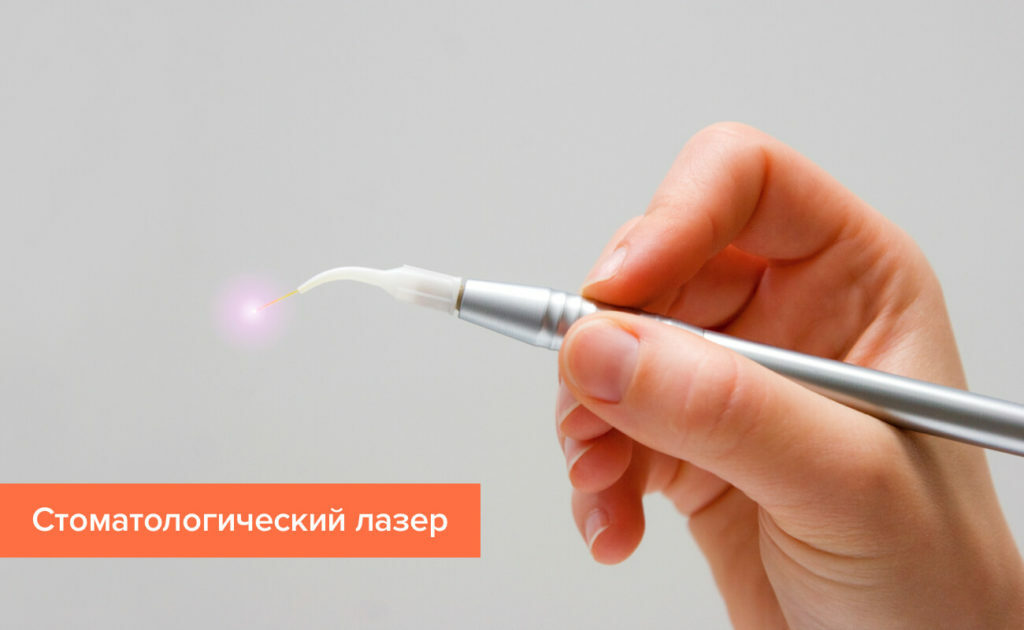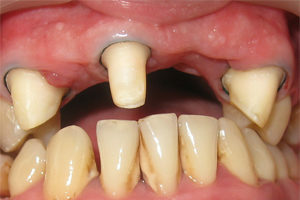 Teeth preparation is an irreversible process, therefore it is very important that it is carried out by an experienced specialist in compliance with all norms and requirements.
Teeth preparation is an irreversible process, therefore it is very important that it is carried out by an experienced specialist in compliance with all norms and requirements.
This is one of the key stages in preparation for the installation of the crown, and therefore, should take into account not only the characteristics of the structure of the teeth, but also the individual characteristics of the patient.
Content
- What preparation
- teeth Why
- procedure In some cases, make the procedure
- Indications dissection
- Methods dissection teeth
- Advantages and disadvantages of each method
- Ultrasonic method
- Laser teeth preparation
- Tunnel preparation
- chemicals
- air-abrasive method
- Varieties of ledges with sharpening of
- Stages of preparation procedure
- Features of procedure
- Preparation for coronas
- Asphalting for
- For
- tabs Reversal for prosthesis
- Splicing for splicing
- Common Questions
- How many fabrics are removed from the tooth?
- Is it painful to dissect a tooth?
- How long does the procedure take?
- Can I install a prosthesis without preparation?
- Is it possible to do preparation for children?
- Why do teeth and gums after the preparation, and what to do about it?
- Consequences and complications
What is tooth preparation
Dissection is the same drilling process that most patients are so afraid of. In simple terms, it is a "turning" of the damaged tooth, which allows you to create additional space used in the restoration process. In this procedure, the upper layers of the enamel and the surface fabrics are ground using a special device having high-speed tips and diamond burs.
Modern dental technology has moved far ahead, so unpleasant sensations such as discomfort and soreness are practically absent. However, most patients are still afraid of this procedure because of the psychological factor. To avoid this, it is necessary to understand a little the technology of the process.
Why the procedure
As mentioned above, the procedure is necessary to prepare the tooth for the further restoration process. Unfortunately, modern dentists have no other option, so grinding is necessary in any case of recovery.
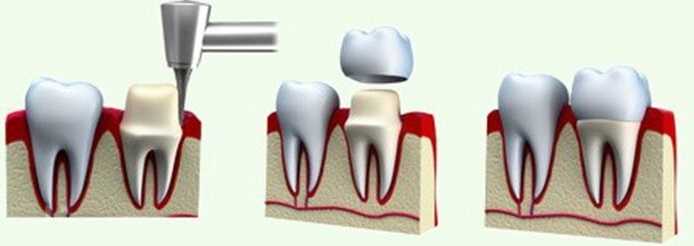
The whole point is that the tooth has an irregular geometrical shape, which does not allow to install the prosthesis sufficiently tightly. Therefore, the convex side walls must be gently ground to give them the correct conical shape. It allows you to set the crown in such a way as to avoid the slightest gaps and prevent the recurrence of caries or other problems.
In which cases do the procedure
This procedure is necessary in almost every case of restoration of the oral cavity:
- Restoration and replacement of already installed seals. Turning is necessary in the event that the old seal has significant defects.
- Recovery after fractures. Often not only the form is disrupted, but there is also increased sensitivity.
- Restoration of birth defects.
- As part of another restoration treatment. Twisting of supporting teeth during prosthesis installation.
Indications for the preparation of
In addition to the installation of crowns, there are still some indications for the procedure.
During the enamel removal procedure, a carious process can be detected, in which case it must also be removed to avoid spreading to adjacent teeth. In addition, the infected dentin remains in the cavity, which is also supposed to be removed.
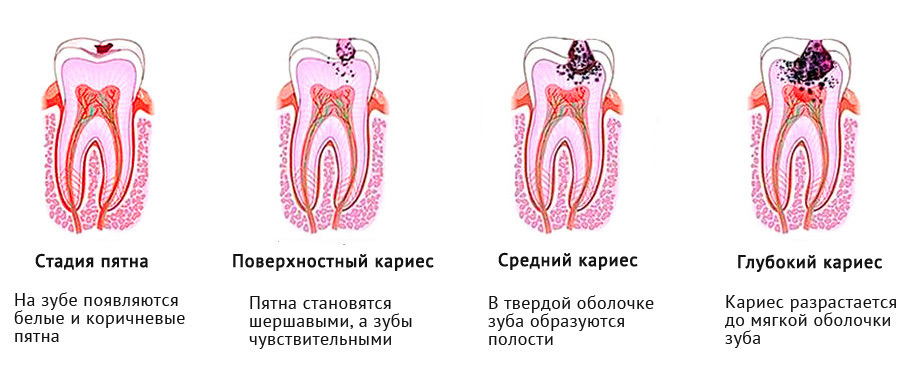
Another case in which grinding will be necessary - a deep lesion with caries of several teeth at once. In this case, before starting any restoration actions, it is necessary to remove all carious tissues and fill the cavities with temporary seals. Only then can the restoration process begin.
Teeth dissection methods
Each restoration dentist owns several turning techniques and determines in which case each of them is more suitable for the patient.
The main methods of preparation are:
- Ultrasound .The surface is grinded by vibration of the instrument under the influence of ultrasound.
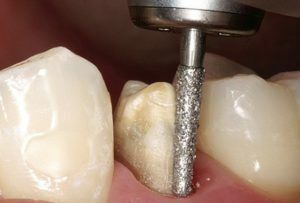
Tunnel grinding
- Laser .Pulsed lasers heat water in the tissues of the tooth, which can be easily removed with an air-water mixture.
- Tunnel .Turning is carried out using a special metal or diamond tip with a high speed of rotation.
- Chemical .Turning is carried out with the help of biologically active substances, in particular, acids.
- Air-abrasive .Instead of a drill, a special mixture is used, fed at high pressure, which causes the destruction of tissues.
Advantages and disadvantages of each method
It is not possible to single out any of the dissection methods separately, as they are selected individually for each case of restoration and treatment. However, in each method there are certain pros and cons.
Ultrasonic method
The ultrasonic procedure has practically no drawbacks. Ultrasound does not affect the tissues of the pulp, a small amount of heat can not overheat the dentin or enamel, there are no chips and cracks completely. In addition, the procedure is as painless as possible.
Laser preparation of teeth
The laser procedure is carried out almost noiselessly, the treated tissues do not heat up, cracks and chips do not form. However, this method is used only for surface treatment.
Tunnel preparation
Tunneling is one of the most common, because it is the easiest to use and allows you to accurately control the thickness of the surface to be rubbed. This method, unlike others, has several key drawbacks.
The enamel is overheated during the procedure, therefore the installation must have a special cooling device. If the tool is poor-quality or heavily worn, there is a risk of cracking, and in the event of a breakdown, even injuring the soft tissues of the oral cavity is possible.
Chemical substances
The chemical method also allows not to heat tissues, it is painless, even microcracks are absent in its application. The main disadvantage of chemical exposure is the duration of the procedure.
Air-abrasive method
Air-abrasive treatment is painless, without excessive heat generation and fast enough. However, this method is not used on its own, as it only affects the upper layers. It is used in conjunction with other methods for preparing the teeth for the installation of permanent structures.
Varieties of ledges in case of turning
The ledge is the solid after the turning, on which the future prosthesis will be fastened. They are divided into several types:
- Knife-like .It is used for installation of solid constructions. Its width is 0.3-0.5 mm.
- Rounded .It is also called gutter. It is used for metal-ceramic prostheses. Has a thickness of 0.8 mm to 1.3 mm.
- Shoulder .It is considered the most durable, reliable and aesthetic kind of ledge. Its width is on average 2 mm.
Stages of the
preparation procedure The turning is carried out in several stages, in total there are 6 clinical steps:
- First of all, you need to determine the number of tissues that need to be removed. For this, special incisions are made-grooves.
-
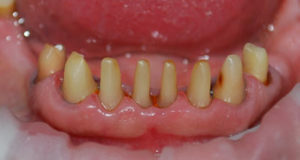 Next, removal of excess fabrics from the convex side surfaces of the enamel takes place.
Next, removal of excess fabrics from the convex side surfaces of the enamel takes place. - Grinding of the chewing surface, on average, removes about a quarter of the crown.
- Next, you need to gently push back the gum to create a mold.
- Then follows the step of forming the ledges described above.
- At the final stage all bumps, hillocks and edges are polished.
Features of the
procedure Depending on the design that you plan to install, the grinding may differ.
Preparation for crowns
If it is planned to install solid-cast structures, then turning begins from the side surfaces to exclude damage to adjacent teeth.
For cermets, depulpation is also required. The doctor removes 2 mm of thickness from each side and selects the shape of the ledge corresponding to the chosen design. For cermets, the surface of the enamel is left uneven to ensure maximum adhesion.
For the porcelain crown, the tooth is grinded in the form of a cone, with the shoulder being immersed in the gum approximately 1 mm.
If the crown is made of zirconium, then the ledge has a pleated or rounded shape, with clearly defined boundaries.
Veneering under veneers
Since veneers are external overlays, the main attention is paid to the frontal surface of the tooth enamel. The lateral sides are treated either with the preservation of the interdental contact, or the borders of the ledges are displayed on the inner side( thus achieving the maximum aesthetic effect).
For tabs
The tab is a partial prosthesis that is inserted into the tooth cavity. It is very important for the preparation to withstand all angles and maintain even walls of the cavity so that the prosthesis contacts the tissues as tightly as possible.
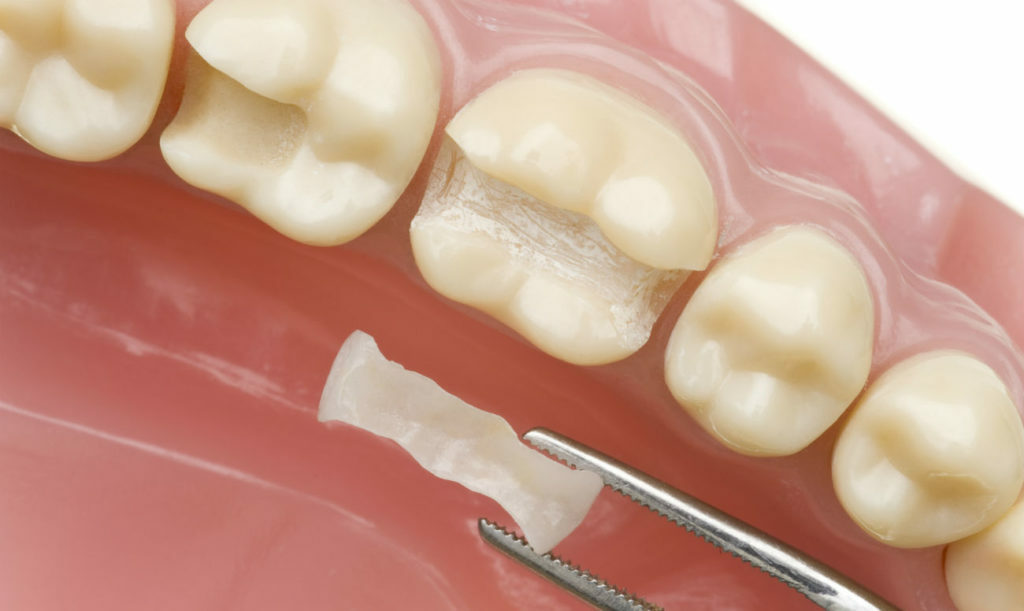
Brushing for prosthesis
The procedure is necessary in case of installation of bridges. Since bridges are similar to crowns by the principle of their work, the dissection is carried out according to the same scheme.
Splicing when splicing
Since splinting is a procedure that fastens the dentition and prevents reeling, it means the maximum retention of hard fabrics. Before installation, the minimum turning of enamel is carried out.
The most common questions of
Many patients are keenly interested in the question of what exactly preparation is, as this term is not well-distributed. We tried to answer the most common questions that arise in patients.
How many tissues are removed from the tooth?
The amount of the removed fabric depends not only on the purpose with which the grinding is performed, but also on the characteristics of the surface and its primary dimensions.
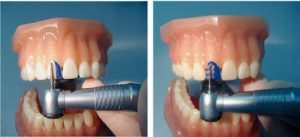 According to the rules for the preparation of hard tissues of teeth in orthopedics, on average the maximum cut is 2 mm, but may be more.
According to the rules for the preparation of hard tissues of teeth in orthopedics, on average the maximum cut is 2 mm, but may be more.
For example, to set the tabs, it is necessary to leave a minimum of 0.5 mm of fabric on each side adjacent to the prosthesis.
Thus, the amount of waste fabric depends entirely on its original quantity.
Is it painful to dissect a tooth?
Modern technologies in dentistry have stepped far ahead. However, at the psychological level in most patients, any procedure seems painful. The newest methods allow to make even such procedure, as preparation absolutely painless.
How long does the procedure take?
How long will the procedure take will depend on the doctor's chosen method of preparation and the purpose with which it is done. On average, one visit to the doctor will take from 30 minutes to 2 hours, depending on the overall restoration plan.
Can I install a prosthesis without preparation?
Unfortunately, it is impossible to install a prosthesis with high quality without grinding. There are several gentle methods that allow you not to grind the teeth adjacent to the prosthesis, but no more.
Is it possible to do preparation for children?
It is possible to conduct turning to children, however young patients are the most problematic, since they negatively concern the apparatuses that perform dental manipulations.
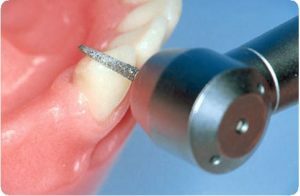
In addition, milk teeth, due to their anatomy, do not allow for complex procedures.
The easiest way to prepare a child is chemical, as it causes the least discomfort. Now, dentists are in search of an alternative method of restoration of baby teeth.
Why do teeth and gums hurt after the preparation, and what to do about it?
Incorrectly performed preparation often destroys the gingival margin, which causes inflammation. Specialists recommend in this case to use anti-inflammatory drugs or to perform a laser procedure. If you do not take care of this problem in time, then periodontitis can develop.
Consequences and complications of
Complications can occur only if the procedure is poor. Most often they consist of inflammation of the gums.
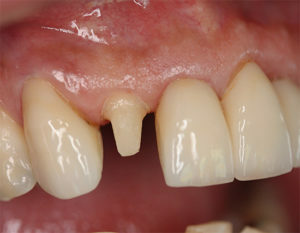
However, if all affected tissues have not been removed, secondary caries can develop which will lead to loss of the supporting tooth.
In order not to face problems and complications after preparation, it is very important to select an experienced specialist. To do this, you need to contact a certified clinic and get acquainted with the reviews in advance.
In addition, it is necessary to choose the correct method of carrying out the procedure, this can be done only by an experienced doctor.
No need to delay and postpone treatment for later, since without timely medical intervention you can face more unpleasant consequences and even lose a tooth.

